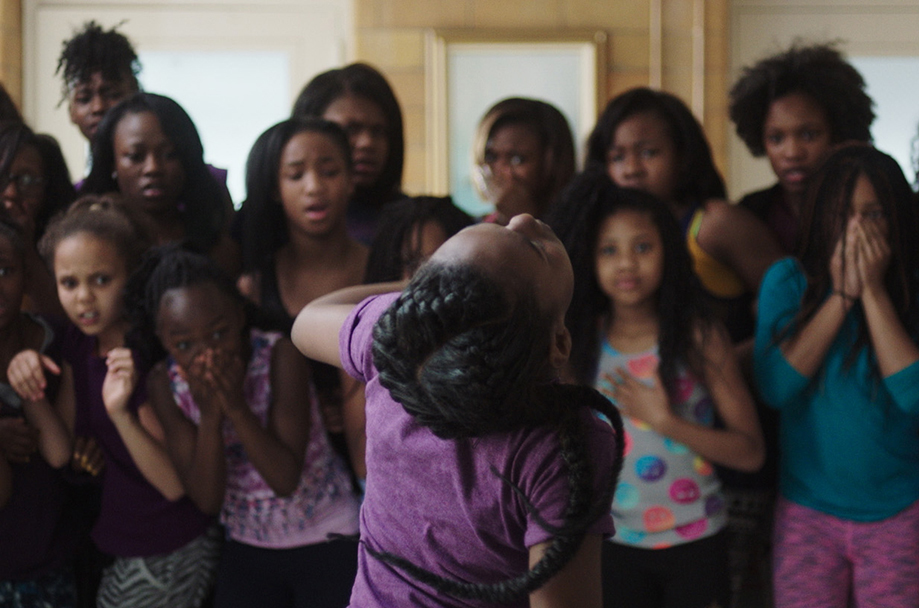There was some magic in the air when Royalty Hightower strutted to top of an overpass in Cincinnati’s West End to perform what would become the turning point in “The Fits.” It was at the end of the first week of shooting Anna Rose Holmer’s dance-driven paean to puberty, when then-nine-year-old, who was discovered by the director along with her dance squad the Q-Kidz during some lonely late-night YouTube searching, was asked to express herself physically, with the filmmaker just off to the side talking to her through the take. There would be no music to rely on for the first-time actress, just her own internal metronome.
“That’s about her accessing the beat and the music, even when it’s not there,” says Holmer, before a grin creeps across her face. “That’s also the day she turned 10 [in real life].”
The crew could only stand back and watch in awe as Hightower wildly gesticulated as if emerging from a cocoon, a transformation that’s captured in all its glory in “The Fits.” A vivacious celebration of becoming a young woman, the film follows Hightower’s Toni from accompanying her brother to work in the basement of their local community center, folding towels and filling up water bottles at a boxing gym, to wandering upstairs to discover an unexpected passion for dance as team tryouts start. Yet making the troupe is hardly the end goal, with smaller victories such as Toni finding a friend in Beezy (Alexis Neblett) or quietly passing through such rituals of girlhood as piercing her ears a sign of growing confidence, even as concern heightens about a rash of spasms overtaking the other girls around her, thought perhaps to be caused by the local water supply.
Holmer, who cut her teeth in the camera department – most prominently, with cinematographer Jody Lee Lipes on such films as “Tiny Furniture” and “Afterschool,” before she produced his second feature, “Ballet 422” — films all this with an exacting eye, letting the natural effervescence of the story and her star Hightower shine through, even as she allows in touches of horror both cinematic and all-too-prescient in setting the film in an economically depressed African-American community. It’s a magnificent narrative debut and as “The Fits” begins to shake its way across the country, Holmer spoke about the inspiration for the film, how she let the reality of where the film was made influence what ended up on screen, and building a strong culture of collaboration on set.

While I was producing “Ballet 422,” I was very fascinated with real, historic cases of mass psychogenic illness conversion disorder and hysteria, and re-imagining that in a dance film was really what was the trigger for me. I really didn’t know what dance form it was going to be at all, but that was where it started.
From what I understand, the way you found the Q-Kidz dance team online was fairly random as was the fact that a water crisis is perceived as what’s causing the hysteria in the story, but as an African-American squad from an economically depressed part of Cincinnati, has it been surreal afterwards to see what’s been happening in Flint, Michigan?
Yes, it’s strange and we’re digesting it. We weren’t aware of what was happening in Flint when I started writing this in 2013, but in real cases, often the communities look for external factors, so that was what that was a nod to — that if these things really did start happening to girls, the adults in the community would try to point towards something that was external and we pointed to water. Now I think audiences carry a different weight to that than we necessarily built in by design, so we’re grappling with the implications of that.
Did you have a pretty firm idea of the story before finding this team in Cincinnati or did they reshape it once you knew they’d be involved?
We had a pretty clear structure going in, but there were a lot of things that were open. We really wanted to cast all the girls in the film from the same team, so we were looking for dance form and a team at the same time and what I really said was, “Do you want to collaborate with us on this?” When they said “yes,” we were really inspired by the locations and started to work with that specific place in mind and drill [routines] in particular were so exciting. Then when we got to filming, I lived on location for nine weeks total, six of which were before we started shooting where we workshopped and invited the kids to be really authors alongside of us and break down their dialogue. That was very important for us just philosophically, but the core of what the film was remained intact. We could’ve gone to many places, because there was nothing implicit in the original form that dictated [a certain location], but the specifics of it changed [once we settled down].
The story seems tailored to the location of this community center where the boxing is downstairs and the gym where the girls dance is upstairs, and then during the rare moments you go outside, it really matters. Was that just as much an influence?
Almost every single location in the film is actually [in] a single location. The bathrooms were in a different building because I wanted color in the bathroom, so we went to a high school. But we wanted to keep it very claustrophobic, very lean. Even when we go outside, you don’t get true relief. The overpass is kind of an enclosed space. The pool is like a room. We wanted to keep that tension and we started to talk about what these spaces represented. In our mind, the overpass is like her bedroom, the laundry room is like their living room, and we really wanted to focus on those few hours after school in the community center and keep the entire story in that space.
I couldn’t help but notice you might’ve been influenced slightly in how you shoot architecture and the human form by “Ballet 422” director Jody Lee Lipes, who’s been a cinematographer on such films as “Martha Marcy May Marlene.” Since you came up in the camera department, was visual language a starting point for figuring out how to tell this story?
I learned a lot from Jody as a [director of photography] and my DP for this, Paul Yee, also was his gaffer for a long time, so we share that vocabulary. Cinematography is my base, I think visually and during the script-writing process with two other women [Saela Davis and Lisa Kjerulff], I almost went immediately to storyboarding. The entire time I was simultaneously thinking about where’s the camera going to be? What are we seeing? What are we not seeing? And using lensing as a way to get into Toni’s head space.

Actually, they came on after the first rough cut of the film. We only wanted to use the score in very specific moments and a lot of that was just about breath and using the instrument as if it were the body [where] it’s not just about the end note, but the process and all the sounds that happen between the mouth and the end of the horn. The clap is so exciting when they introduce that. It was a real collaboration. It was very experimental and a lot of the notes that I gave them were the same that I gave our choreographer — they’re very focused on body.
You’ve said each of the girls worked out individually with Celia Rowlson-Hall, who was brought on as a movement consultant. Why was it important to keep them separate from each other?
They were developed in isolation so they had no reference, which was really important to us, for them to be very unique, visually and experientially. Celia was a great collaborator and she and I talked about trigger points and she really workshopped with each one of them one-on-one and they only performed [their dance] the day that we filmed. On the overpass sequence [where Toni finds her rhythm], [Celia] worked very heavily with Royalty while breaking down the choreography into almost workout reps and what Toni learns [in that scene] is that it’s not about individual steps, but that there’s a flow. It’s more about the in-between moments.
What was the balance of what you wanted your actors to bring of themselves versus what you might’ve needed to tell the story you wanted to tell?
With any actor, you want them to bring new ideas to set and that’s what I asked and required of my cast as well. It’s hard because I’ve never worked in a different way, but everyone wants to know that you’re going somewhere. This is not an empty exercise, that someone is taking into consideration the greater film that you’re making and it’s not just about the single moment, it’s about the full experience so they trust you to let them know if they’re on that path. It’s about being open and vulnerable if you’re going to ask someone to give on screen, so you have to give to them too.

I think the director is definitely sets the emotional tone on set, but collaboration is what makes cinema such a beautiful art form and it’s the director’s role to take responsibility for synthesizing those collaborative conversations into a singular experience. It’s also your responsibility to create a safe space where you’re collaborators can experiment and fail, and I don’t mean that in a negative way. Failure’s a really positive part of growth, and [as a director] you can take the responsibility off of them — that failure will not end up on screen — and they trust you in that way. It’s quite emotionally demanding to direct. It’s not a top-down [experience], it’s about gathering and amplifying the voice of your collaborators.
Since the film’s tone is unique, invoking some instances of magical realism, is it difficult to give yourself permission to go to those places?
If you’re always afraid of what the worst might be, then you’ll never achieve anything. We were always like fixated on the best-case scenario — when it’s elegant and working together — but the blend of genres comes from putting the audience in the experience of this young girl. When you’re 11, that’s how it feels, to me at least, and working with my two co-writers, Saela Davis, who’s my editor, and Lisa Kjerulff, my producer, we were just talking about shared experiences [where] there are these moments of hyper-reality and then those memories start to lift and you almost can’t remember if it was a dream or if it really happened. We were trying to get to that place.
“The Fits” is now open in New York at the Metrograph, Cincinnati at the Esquire and Los Angeles at the Pasadena Playhouse 7 and the Monica Film Center before expanding on June 17th. A full list of theaters and dates is here.




